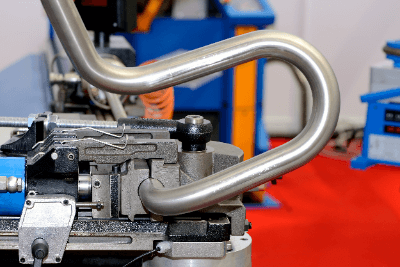What Is Pipe Bending?

Pipe bending is a processing method that uses a processing machine called a “bender” to process parts by bending metal pipes.
Various metals such as copper, aluminum, iron, and stainless steel can be processed depending on the application. It is mainly used to process parts for automobiles and piping components.
Since “benders” are now available at home centers, more and more people are purchasing them for their personal use and performing pipe bending.
Uses of Pipe Bending
Metal pipe parts used in familiar items such as piping for various types of equipment, automobile mufflers, and pipe chair legs are made using this processing method. Generally, most of them are made of materials such as “aluminum,” “copper,” “iron,” and “stainless steel,” but metals such as “titanium” and “brass” can also be processed.
Also, the cross-sectional shape of pipes is not limited to the often seen circular shape but can be processed in a variety of cross-sectional shapes such as square and oval. However, there are limits to the shapes that can be processed depending on the shape of the pipe and the combination of materials, so it is necessary to consider the best combination for each application.
Principle of Pipe Bending
The following are some of the important elements of pipe bending. These elements are common to all of the typical bending shapes shown below.
- Tensile stress
This is stress that occurs in the direction of pulling on the outside of the bent section. This causes the outside of the pipe to decrease in thickness and in some cases to become slightly concave. - Compressive stress
Contrary to tensile stress, this stress occurs in the direction of inward crushing. This can cause wrinkles on the inside. - Inside Bending R
This is the inside bending radius when bending a pipe. If this is made smaller, the tensile stress in (1) will increase and the outside will crack, or the compressive stress in (2) may cause wrinkles on the inside. Care should be taken especially with soft materials such as aluminum, as they are prone to wrinkling. - Minimum Bending R
The smallest inner bending R value within which the pipe will not crack. If bending is attempted with a radius smaller than this value, cracking will occur. Since there are differences depending on the material, plate thickness, shape, etc., care must be taken when considering processing.
There is a countermeasure to prevent cracking by using annealing materials.
Typical bending shapes are introduced below.
- Acute angle bending
Bending at an angle of less than 90°. - L-shape bending
Bending at a right angle like an “L”. In this process, it is necessary to pay attention to the phenomenon called “springback,” in which the angle opens back a little more than the angle at the time of bending. Aluminum, in particular, has high elastic deformation, so it needs to be bent extra large compared to other metals. - Obtuse angle bending
This is a method of bending at an angle narrower than a right angle (about 95° to 175°), like the letter “L”. It is sometimes called “V-shape bending” depending on the item. - U-shape bending
This is a method of bending 180° like the letter “U”. In this process, the beginning of both sides are bent first, and then the center part is bent. This process has the advantage of preventing contact with the die and making it easier to produce symmetrical products. - Box-shape bending
This is a method of bending in the shape of the letter “U”. The L-shape bending described above is performed twice, and since the L-shape bending is performed twice, it is more difficult to obtain a more accurate angle than the L-shape bending. - Z-shape bending
This is a method of bending in the shape of the letter “Z”. Even if the line is not diagonal like a perfect “Z,” it is still called a Z-shape bend.
By combining the various bending processes described above and joining multiple parts that have been bent together by welding or other means, a desired shape can be achieved.
Although individual processing is possible, there are limits to individual processing for high-precision processing and extremely thick or thin pipes, so it is necessary to request a specialized manufacturer depending on the specific application.